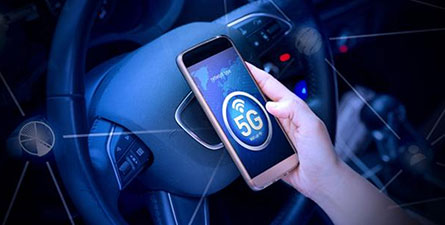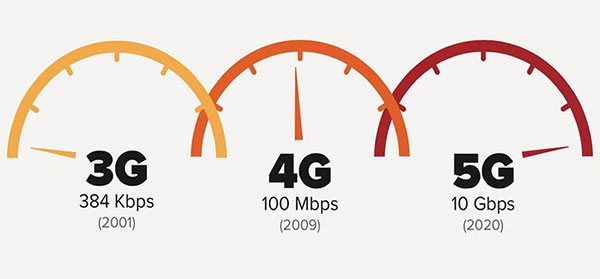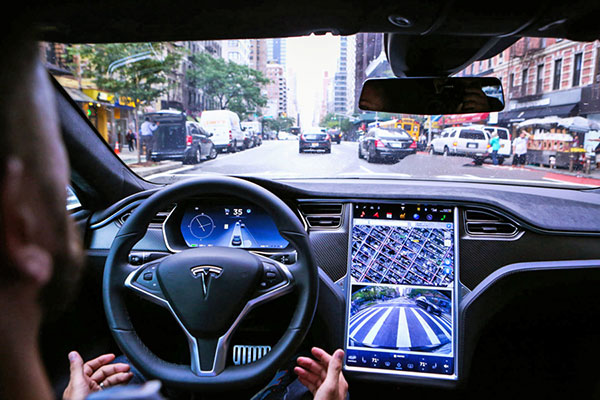News Center

5G seems to be coming faster than we thought, and compliance and safety issues for 5G applications to autonomous driving have become hot topics. It is undeniable that both in terms of the amount of data transmitted and transmission speed, 5G is the basis for achieving L5 level autonomous driving, and it will also be safer than human driving.
The transmission speed of 5G is more than 100 times faster than 4G, which is enough to realize the low-delay interconnection between cars and people, cars and facilities. In addition, with the benefit of edge computing, it will be easier to manage infrastructure with large amounts of unstructured data.
The automotive industry is experiencing exponential growth in autonomous driving capabilities, and this trend will continue. 5G connectivity will make autonomous driving faster, smarter and safer.

The momentum for achieving self-driving cars has rocketed. Companies like Tesla (TSLA) and Toyota (TM) are currently testing self-driving cars on roads in places like Pittsburgh, Boston and Phoenix. A recent fatal accident involving a driverless Uber vehicle has led many to question whether the public has serious concerns about self-driving cars: whether they will ever be safe enough for people to feel confident sharing our roads with them.
Nevertheless, with the widespread adoption of autonomous driving features, it seems that L5 level self-driving cars will appear on our roads in the near future, and possibly faster than people realize. More surprisingly, they are also much safer.
Many experts believe that in order to fully unleash self-driving car technology, 5G wireless technology must be adopted on a large scale. The current 4G network speed is not yet able to support the application of safer and smarter self-driving cars.
In an interview with the BBC, Nokia's Jane Rygaard said: "We need to look at the time it takes the information to travel from the sensor to the ECU in the car, and the time it takes the ECU to make a decision, all of which has to be two milliseconds shorter than the time it takes a human to make a decision. So 5G technology is essential."
Current 4G network speeds are not enough to allow self-driving cars to react so quickly, and driverless is just one of the many incredible technologies that 5G will enable. Virtual reality and artificial intelligence are two other examples of what we can expect.
Evolution of network
Wireless data networks have grown steadily over the past 30 years, and several life-changing technologies have followed. In the early 1980s, the first analog mobile phone system was born. Cell phones were rare back then, but people could finally talk to each other on the road.
By the early 90s, second generation and 2.5G mobile systems enabled people to send text, but it wasn't until the millennium that people were able to access broadband Internet over 3G. The mobile phone has evolved from a device for making phone calls to a tool for multi-faceted communication, entertainment and shopping.

The arrival of 4G provided enough bandwidth and speed to allow real-time information and location sharing. This evolution has given birth to the sharing economy, giving rise to companies like Uber and Lyft. However, it is not enough to support technology with human-like reaction speeds, and 5G comes into being.
Why 5G is so important for autonomous driving
5G is expected to connect everything around us with ultra-fast, highly reliable and fully responsive networks. 5G will have the potential to enable us to take full advantage of advanced technologies such as artificial intelligence, virtual reality and the Internet of Things.

Hundreds of sensors built into self-driving cars could make them faster and smarter. These sensors generate unprecedented amounts of data, far more than any other iot application. Processing and analyzing this data requires networks that are faster than existing 4G technology. Self-driving car systems require incredible data processing power and speed, which requires mimicking human reaction times.
According to Dr. Joy Laskar, Chief Technology Officer of Maja Systems, the self-driving cars of the future will generate nearly 2 megabits of data. "A week of data transfer in an autonomous car takes 230 days, which is why we need faster ASIC processing technology," - Laskar.
We show as many use cases as possible to the public as early as possible. Demonstrate on-vehicle 5G technology to car companies so they can understand how data is transferred in the vehicle; The way cars work, security, bandwidth, and user experience will all change. The driver does not have to concentrate on where the car is going and what it is doing. As drivers are freed up, the bandwidth demands on cars will grow exponentially.
The world's leading semiconductor companies such as Intel and Qualcomm are moving toward an ASIC revolution, studying the difficult problem of how to combine 5G bandwidth with digital radio and antenna architecture. In short, these companies are developing chips that will turn self-driving cars into mobile data centers that allow driverless cars to make real-time, complex decisions.
Market observers say that if 5G is fully adopted, Internet speeds will be 100 times faster than 4G, and it will enable V2V and V2X connectivity. In addition, the technology's low latency will make these vehicles safer and more reliable on the road - safer than current human-driven vehicles.
5G drives edge computing
Edge computing offers a range of advantages and is considered by many experts to be one of the latest important enterprise trends. Edge computing refers to the side near the object or data source, using the network, computing, storage, application core capabilities as one of the open platform, to provide the nearest service. Its applications are initiated at the edge, producing faster network service responses that meet the industry's fundamental needs in real-time business, application intelligence, security, and privacy protection. Edge computing is between physical entities and industrial connections, or at the top of physical entities. When it comes to edge computing, there are many challenges when it comes to network reliability.
Managing the infrastructure for large amounts of unstructured data and protecting privacy when collecting sensitive data at the edge is a major challenge for autonomous driving. With the lightning-fast response time of edge computing, as well as 5G's low latency and ability to offload computing tasks, it will give it better location awareness.
Remote control
In addition, specific safety measures are included in the vehicle. Suppose a self-driving car is unable to drive due to a traffic jam caused by an accident.
Self-driving features could hand control to the driver. However, if you are elderly or disabled, it is a different matter. For this reason, many companies have been testing remote pilots, trained drivers who sit miles away in simulators and can take over immediately. However, for this to happen, stable and fast connections for 5G will be crucial.
In addition, 5G will provide high-quality infotainment services for passengers in self-driving cars. Whether for data analytics, safety or entertainment, communication service providers will be important partners for autonomous vehicles.
5G technology still has the potential to further improve autonomous driving technology, such as the regular inspection of the safety performance of autonomous driving will be a small potential.
Don't be afraid if you see driverless cars on the road, consider the evolution of smartphone devices over the past few decades. At one point, you probably couldn't even imagine being able to call someone on the other side of the world with a pocket-sized device.

The development of technology and the Internet has brought incredible progress to society. 5G will lead to safer and smarter self-driving cars, which will be one of the most significant outcomes of our time.
(Credit: Geste Motors)
Return to Overview